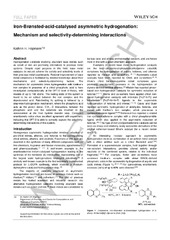Iron/Brønsted Acid Catalyzed Asymmetric Hydrogenation: Mechanism and Selectivity-Determining Interactions
Permanent link
https://hdl.handle.net/10037/9772Date
2015-06-03Type
Journal articleTidsskriftartikkel
Peer reviewed
Author
Hopmann, Kathrin HelenAbstract
Hydrogenation catalysts involving abundant base metals such as cobalt or iron are promising alternatives to precious metal systems. Despite rapid progress in this field, base metal catalysts do not yet achieve the activity and selectivity levels of their precious metal counterparts. Rational improvement of base metal complexes is facilitated by detailed knowledge about their mechanisms and selectivity-determining factors. The mechanism for asymmetric imine hydrogenation with Knölker’s iron complex in the presence of chiral phosphoric acids is here investigated computationally at the DFT-D level of theory, with models of up to 160 atoms. The resting state of the system is found to be an adduct between the iron complex and the deprotonated acid. Rate-limiting H2 splitting is followed by a stepwise hydrogenation mechanism, in which the phosphoric acid acts as the proton donor. C[BOND]H⋅⋅⋅O interactions between the phosphoric acid and the substrate are involved in the stereocontrol at the final hydride transfer step. Computed enantiomeric ratios show excellent agreement with experimental values, indicating that DFT-D is able to correctly capture the selectivity-determining interactions of this system.
Description
Accepted manuscript version. Publisher's version available at http://doi.org/10.1002/chem.201500602.


 English
English norsk
norsk